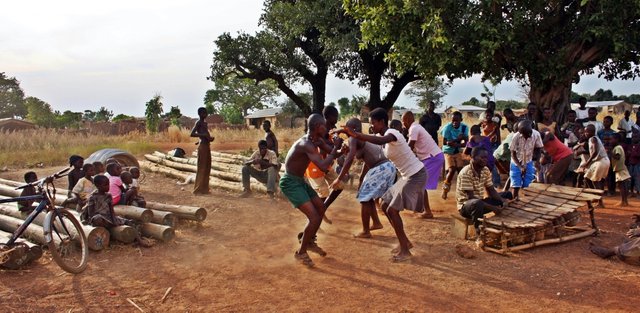What Do you know about the Dagaaba people? (2)

Traditional Dagaaba communities are based on the "Yir" subclan or household group, a series of which are clustered into the "Tengan", an earth deity shrine area. The Tengan system, a constellation of roles usually inherited within the same household group, is called the tendaalun. The head of these shrine area systems, the tengan sob (sometimes tindana) fulfilled the role of community elder and priest, along with the tengan dem, the ritual custodian and maintainer of the ritual center. Other priestly/elder roles within the tendaalun include the suo sob who performs ritual animal slaughter to the earth deity, the zongmogre who performs rituals at the sacred market centres, and the gara dana or wie sob who is ritual leader among hunting societies. These remain living forms of community in much of Dagaaba society, and influence, among other things, the community perception of land as held in spiritual custodianship, and different community resources falling under the custodianship of different authorities, lineages, and/or spiritual forces.
Until the latter part of the nineteenth century when institutional chieftaincy evolved (and was latter imposed by colonial administration), broader Dagaaba communities functioned under a system of councils of elders.
Some Dagaaba communities maintain traditional ceremonial chieftainships, sometimes contesting. As recently as 2006, the "Council of Elders" of the Dagaaba community of Ghana attempted to unite various factions with the appointment of Naa Franklin Suantah, Principal Librarian of the Saint Louis Training College of Kumasi as chief of the Dagaaba community in Ghana.
Dagaaba communities historically have practiced Traditional religions, as well as Islam and Christianity. The Ghanaian Dagaaba have traditionally had a Cousinage/Joking relationship with the Frafra (Gurunsi) people. The Dagaaba, before the influence of the colonialist, were self-reliant in iron production and were very successful in mixed crops farming. They also developed sophisticated musical instruments including gyle (xylophones).
Communities in Dagaaba homelands remain primarily small scale agricultural, with family farming plots tilled by the family themselves. In the modern era, off-farm wage income is often used to supplement trade income and subsistence from farming. Fishing communities of Dagaaba persist along the Black Volta, a de facto boundary of Dagaaba lands. Because the communities are found along historic coast-to-Sahel trade routes, trade has long been an important occupation, but largely in local goods. Markets in larger towns are on Sundays, with others on a six-day cycle.
Some contemporary Dagaaba communities of northern Ghana are notable as the last West African communities to still use Cowrie shells as currency, alongside the modern Ghanaian cedi. Cowrie are used not only for traditional ornamental and ceremonial purposes (as other West African communities do), but also as an inflation proof form of internal savings and as a safe medium to trade across national (and currency) boundaries which may divide Dagaaba communities.
Oral literature has a long tradition with Dagaaba communities, and remains a living vehicle of education and acculturation in Dagaaba society. There are two main types of literature in Dagaaba society. They can broadly be categorised as secular literature consisting of stories, tales, proverbs and other oral genre and the sacred literature produced during ritual and religious services. The most important of these are bagr mythical narratives recitations and orations produced during initiation rituals and other religious services.
The Dagara people of West Central Africa successfully categorize their members into five different categories: fire, water, mineral, earth and nature. These are shown above on the African Wheel with the colors the Dagara normally associate with each type. Each of the five types of people play a very specific role. Some shady contentions have it that"Every person born into this world comes from one of these categories in order to help fulfill the kind of function hat category of people is supposed to fulfill in order to keep the community together".
Posted from my blog with SteemPress : https://northernghana.net/2018/06/23/what-do-you-know-about-the-dagaaba-people-2/